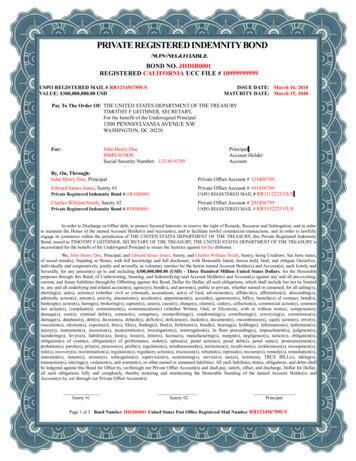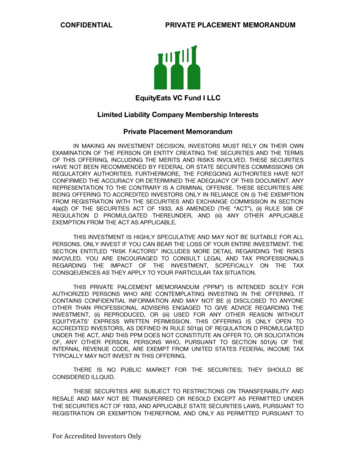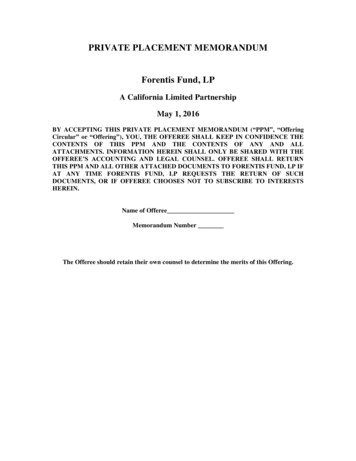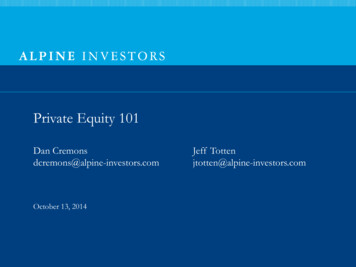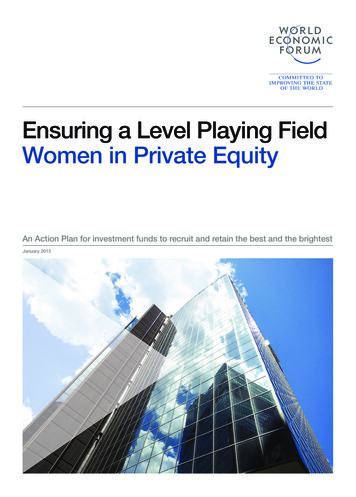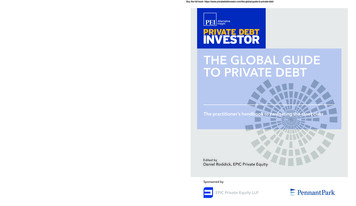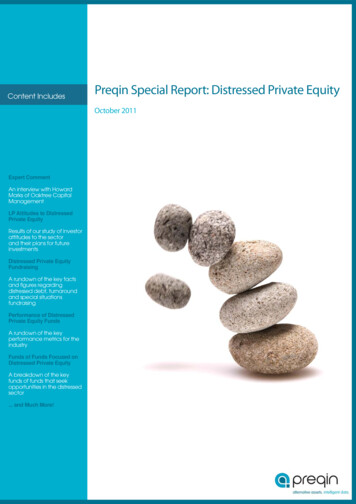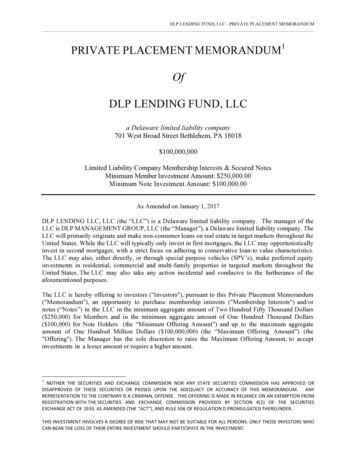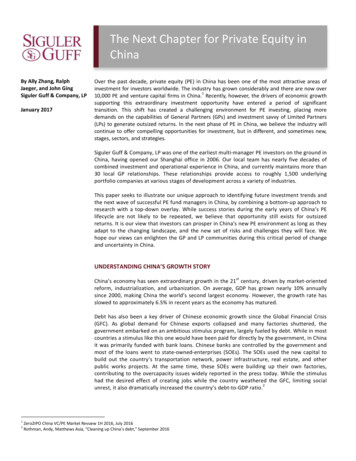
Transcription
The Next Chapter for Private Equity inChinaBy Ally Zhang, RalphJaeger, and John GingSiguler Guff & Company, LPJanuary 2017Over the past decade, private equity (PE) in China has been one of the most attractive areas ofinvestment for investors worldwide. The industry has grown considerably and there are now over110,000 PE and venture capital firms in China. Recently, however, the drivers of economic growthsupporting this extraordinary investment opportunity have entered a period of significanttransition. This shift has created a challenging environment for PE investing, placing moredemands on the capabilities of General Partners (GPs) and investment savvy of Limited Partners(LPs) to generate outsized returns. In the next phase of PE in China, we believe the industry willcontinue to offer compelling opportunities for investment, but in different, and sometimes new,stages, sectors, and strategies.Siguler Guff & Company, LP was one of the earliest multi-manager PE investors on the ground inChina, having opened our Shanghai office in 2006. Our local team has nearly five decades ofcombined investment and operational experience in China, and currently maintains more than30 local GP relationships. These relationships provide access to roughly 1,500 underlyingportfolio companies at various stages of development across a variety of industries.This paper seeks to illustrate our unique approach to identifying future investment trends andthe next wave of successful PE fund managers in China, by combining a bottom-up approach toresearch with a top-down overlay. While success stories during the early years of China’s PElifecycle are not likely to be repeated, we believe that opportunity still exists for outsizedreturns. It is our view that investors can prosper in China’s new PE environment as long as theyadapt to the changing landscape, and the new set of risks and challenges they will face. Wehope our views can enlighten the GP and LP communities during this critical period of changeand uncertainty in China.UNDERSTANDING CHINA’S GROWTH STORYstChina’s economy has seen extraordinary growth in the 21 century, driven by market-orientedreform, industrialization, and urbanization. On average, GDP has grown nearly 10% annuallysince 2000, making China the world’s second largest economy. However, the growth rate hasslowed to approximately 6.5% in recent years as the economy has matured.Debt has also been a key driver of Chinese economic growth since the Global Financial Crisis(GFC). As global demand for Chinese exports collapsed and many factories shuttered, thegovernment embarked on an ambitious stimulus program, largely fueled by debt. While in mostcountries a stimulus like this one would have been paid for directly by the government, in Chinait was primarily funded with bank loans. Chinese banks are controlled by the government andmost of the loans went to state-owned-enterprises (SOEs). The SOEs used the new capital tobuild out the country’s transportation network, power infrastructure, real estate, and otherpublic works projects. At the same time, these SOEs were building up their own factories,contributing to the overcapacity issues widely reported in the press today. While the stimulushad the desired effect of creating jobs while the country weathered the GFC, limiting social2unrest, it also dramatically increased the country’s debt-to-GDP ratio.12Zero2IPO China VC/PE Market Revuew 1H 2016, July 2016Rothman, Andy, Matthews Asia, “Cleaning up China’s debt,” September 2016
The Next Chapter for PrivateEquity in China // 2As shown in Exhibit 1, China’s debt-to-GDP ratio was approximately 160% in 2007. By the end of2015, it had increased to roughly 250%. While higher than other emerging market economies,China’s debt-to-GDP ratio is lower than many of the G-7 nations, and is consistent with that ofthe U.S., also demonstrated in Exhibit 1. It is important to note the composition of China’s debt.The Chinese household debt-to-GDP ratio is low relative to most other developed countries. Atapproximately 40%, Chinese households are much less levered than U.S. households (80% of2GDP) and U.K. households (90% of GDP). The financial products that drove the U.S. financialcrisis in 2008 to 2009 do not exist in China; namely, there are no subprime mortgages and veryfew mortgage-backed securities. In China, homebuyers are required to make a down payment3of at least 20% for first homes and at least 30% for second homes. In the U.S., the median firsttime homebuyer made a down payment of between 3% and 10% in the lead-up to the financial4crisis (2001 to 2008).Exhibit 1: China’s Debt-to-GDP Ratio5,6,7Debt-to-GDP ratio 4224412219United Kingdom20072015Corporate (non-financial)HouseholdsGovernmentFinancial institutionsChinaUnited StatesGermany0100200300400Debt-to-GDP ratio (%)Profit growth and valuation arbitrage, two of the most important sources of returns for PEmanagers in China over the past decade, have been propelled by strong GDP growth, rapidcapital markets expansion, and the high trading multiples of the domestic A-share market(especially the ChiNext stock exchange). However, years of overexpansion have causedcorporate debt levels to more than double, and Chinese companies can no longer rely onexpanding production capacity to grow revenues. In recent quarters, GDP growth has slowed toless than 7%, reflecting a decreasing rate of population growth and slowing fixed assetinvestment. It is against this backdrop that operational efficiencies, rather than indiscriminatecapacity expansion, will become a top priority for Chinese companies and their investors.Across Siguler Guff’s underlying portfolio companies in China, we have observed that multipleexpansion was the key driver of returns from 2005 to 2010. Since then, faced with slowing GDPgrowth, we have observed many GPs turning their focus towards making operationalimprovements to drive profits.We believe that a slowdown in China’s economic growth will contribute to a healthier and morebalanced economy going forward. Tremendous opportunities exist to invest in industriesbenefiting from China’s “consumption upgrade,” such as the consumer, mobile-internet,3Bloomberg, “China Eases Mortgage Down Payment to 20% for First Homes,” February 2016Federal Housing Finance Agency, A Study of First-Time Homebuyers, October 2013McKinsey & Company, “Debt and (not much) deleveraging,” February 20156Bloomberg, “China’s growing debt problem isn’t quite what it seems,” August 20167Bank for International Settlements, September 201645
The Next Chapter for PrivateEquity in China // 3tourism, leisure, education, and healthcare spaces.We believe that a more focused economy will help transform traditional manufacturing to avalue-added, advanced form of manufacturing, characterized by high barriers to entry andtechnological expertise. Additionally, technology businesses will also take their cues from theastounding success of internet-based companies, such as Alibaba and Tencent, which havebecome 100 billion enterprises in just a few years’ time.INEFFICIENCIES IN PUBLIC MARKETS CREATE AN OPPORTUNITY FOR PRIVATE EQUITYThe underdeveloped financial market has been a factor in the advancement of China’s PEindustry. Despite more than two decades of progress in the capital markets, bank loanscontinue to act as the major source of financing for companies in China. The majority ofChinese banks are state-owned and, therefore, most loans are made to state-dominatedsectors such as transportation, telecom and energy. As a result, small and medium-sized privatecompanies — the key growth drivers of the country’s future economy – have suffered from asignificant funding gap. As depicted in Exhibit 2 below, the market capitalization of China’sstock market, as a percentage of GDP, is much lower than similarly-sized economies.Exhibit 2: Stock Market Capitalizations Relative to GDP in 2016Country8U.S.9United Kingdom10Japan11India12ChinaMarket Cap(USD Billion)26,497GDP(USD Billion)18,562Market Cap as aPercentage of 1%106%74%35%The volatility of China’s stock market over the past ten years illustrates the fact that thecountry’s capital markets have been unbalanced and underdeveloped. The public marketsgenerated strong returns and traded at high P/E multiples when China was enjoying strong,double-digit GDP growth, and companies were aggressively seeking capital for businessexpansion. The Shanghai Composite Index traded at an all-time high of more than 6,000 inOctober 2007. However, as the public markets soared, their shortcomings became moreglaring. A rigid, approval-based IPO process not only created a limited supply of new listings onthe exchanges, but helped to inflate a stock market bubble.These elements, along with the GFC, contributed to the crash of China’s stock market in 2008.The equity market crash only made things worse for companies seeking financing fromtraditional channels. As the GFC dampened expectations, private companies seeking equityfinancing in the public markets faced the reality of valuation declines. By November 2016, theprice of the Shanghai Composite Index was nearly 50% below its historical high and trading at aP/E ratio of less than half of its record high in 2007, as shown in Exhibit 3.8Comprises NYSE and NasdaqComprises London Stock Exchange and Borsa ItalianaComprises Tokyo Stock Exchange and Osaka Securities Exchange11Bombay Stock Exchange12Comprises A-share Stock Market910
The Next Chapter for PrivateEquity in China // 4Exhibit 3: Shanghai Composite Index Average Annual P/E Ratios70.0x60.360.0xP/E 4.128.232.927.420.7 20.6 20.110.0x0.0x2003 2004 2005 2006 2007 2008 2009 2010 2011 2012 2013 2014 2015 2016Source: Capital IQ. 2016 data through October 31, 2016China’s rigid IPO policy, in combination with the narrow M&A market and the suspension of Ashare IPOs between October 2012 and January 2014, further limited access to capital forcompanies and also burdened the exit environment for PE managers. Today, despite thereopening of the IPO market, there is a long list of companies still waiting to go public, as wellas a great deal of capital “stuck” in the PE ecosystem. The exit environment should improve inthe future as the China Securities Regulatory Commission (CSRC) carefully executes marketreforms and switches its approval-based IPO listing requirements to a registration-based model.Though volatile historically, as shown in Exhibit 3, valuation multiples of listed companies havegenerally normalized in recent years.For these reasons, PE has played a significant role in China by providing equity financing tocompanies unable to access traditional funding channels. Most of the well-known, fast-growingcompanies in the private sector (e.g., Mengniu, Focus Media, Alibaba, and Belle) have benefitedfrom capital infusions from PE funds. The ability of PE to close the funding gap has generatedoutsized returns for investors in the country since the early 2000s.CAPITAL OVERHANG? YES FOR RMB, NO FOR USD FUNDSWith the influx of PE capital in China, the issue of capital overhang (i.e. too much capital chasingtoo few deals) emerged in 2009. From 2010 to 2014, over 1,000 new RMB-denominated fundsentered the market, as shown in Exhibit 4. Then in 2015, more than 2,000 new RMB funds wereset up. RMB fund managers were attracted to the significant valuation gap between public andprivate companies. Initially, many of these managers were opportunists with little PEexperience chasing pre-IPO deals. This phenomenon inevitably drove up valuations, especiallyin high-growth sectors, as RMB funds had no problem paying high multiples for privatecompanies as long as there was still some room for multiple expansion once those companieswent public. As valuation multiples for ChiNext-traded companies started to decrease, andoperating performance for many portfolio companies was sluggish due to the macroeconomicslowdown, performance of RMB funds suffered.
The Next Chapter for PrivateEquity in China // 5Exhibit 4: New PE Funds in China by DenominationNo. of New PE 4 322 409712006 2007 2008 2009 2010 2011 2012 2013 2014 2015 1H2016RMB FundsUSD Funds3735010312092126209Source: Zero2IPO China VC/PE Market Revuew 1H 2016, July 2016More recently, the Chinese government has started to play a particularly active role in the PEmarket. Local, provincial, and national governments have both committed money to andestablished PE and VC funds. While the GPs of U.S. dollar funds have a fiduciary duty to theirinvestors, investing capital is the end-unto-itself for many of these RMB funds. The primary goalof investing is to support the growth of the country’s private sector rather than to generate13attractive returns for investors. For example, in early 2016, a group of Shanghai governmentdepartments announced that they will begin to partially compensate investors for financial14losses on investments made in the city in an attempt to stimulate the local VC environment.The dramatic increase in the number of RMB funds in recent years has not had a noticeableimpact on the performance of U.S. dollar funds. Rather, the performance of U.S. dollar funds hasbeen consistent and strong over the last ten vintage years for which meaningful return data isavailable. Between 2005 and 2014, Chinese PE & VC funds generated pooled net IRRs greater than15% for every vintage with the exception of 2009. To put this performance in context, CambridgeAssociates’ Chinese PE & VC benchmark, which is comprised of U.S. dollar-denominated funds, hasoutperformed the U.S. PE benchmark by an average of nearly 900 basis points over the last tenvintage years, as demonstrated in Exhibit 5 below.Exhibit 5: Performance of China PE & VC FundsVintage oled Retur
The Next Chapter for Private Equity in China. The Next Chapter for Private Equity in China // 2 As shown in Exhibit 1, China’s debt-to-GDP ratio was approximately 160% in 2007. By the end of 2015, it had increased to roughly 250%. While higher than other emerging market economies, China’s debt-to-GDP ratio is lower than many of the G-7 nations, and is consistent with that of the U.S., also .


